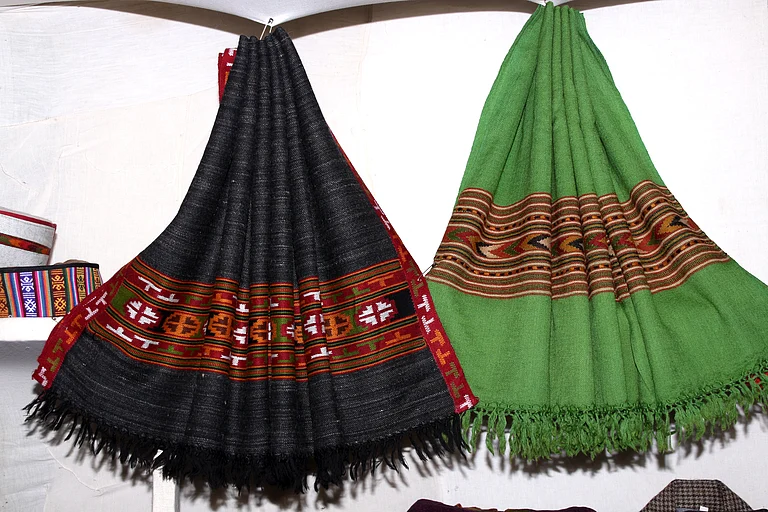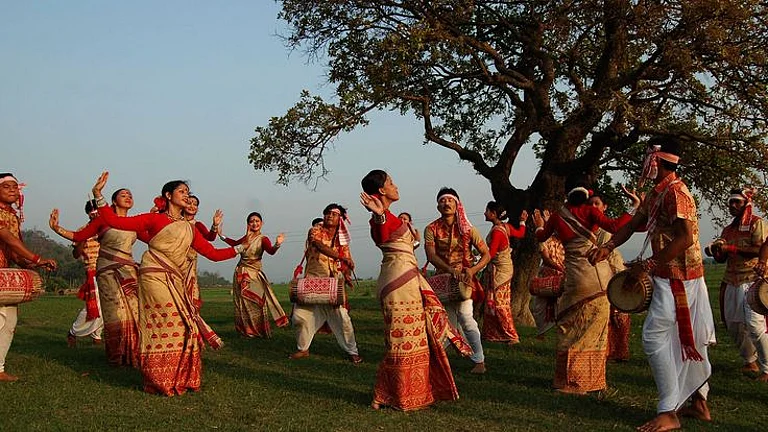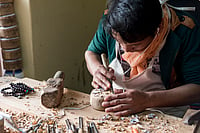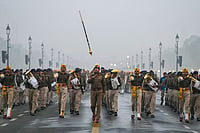Since 2023, when Naatu Naatu clinched the Golden Globe Award for Best Original Song, it has sparked moments of rejoice among folk music lovers in the hills of Himachal Pradesh. It’s because the lyrics and the iconic hook-step dance somehow resonated deeply with the popular and traditional hill folk dance―Nati.
Well, if Naatu Naatu―the electrifying song from the film RRR can transcend its Telugu origins to earn worldwide acclaim, what stops our own Nati folk dance―which is also practiced in the hills of Uttarakhand—receive similar acclaim?
Even as the rich cultural diversity of Himachal Pradesh holds significance to any folk-art forms, few like Kariyala—one of the endangered folk theatrical forms—Nati remains the largest popular folk form. It reflects the culture, tradition and pride of Himachal Pradesh, formed by both men and women—elders and the young.
Kariyala is an all-men performance form. There are no women actors. Men portray female roles. Surprisingly, even today women are not allowed to play female roles. The word “Nati” refers to both the dance and the accompanying songs, which are often sung in local dialects.
In 2016, Himachali Nati found a place in the Guinness World Records as one of the largest folk dance forms when over 9,000 women, clad in traditional attire, came together at Kullu’s Dhalpur Ground to perform Nati, for the first time, as part of the Kullu Dussehra celebrations. This notable accomplishment was the brainchild of Rakesh Kanwar, the young IAS officer and then Deputy Commissioner of Kullu, who sought to elevate Nati to a global stage. Kanwar’s vision was not only to showcase the dance form, but also to inspire women to embrace it as a symbol of shared cultural heritage and collective joy.
Nati has universal acceptability across all regions of Himachal Pradesh―Kullu to Sirmaur, Shimla to Kinnaur. It’s impossible to imagine a Himachali wedding without the infectious rhythm that prompts everyone to join in. Traditional fairs, festivals, religious ceremonies and even common gatherings can drive Paharis to dance to the lyrics and rhythm of Nati music, for hours.
What makes it really vivacious are the lively body movements, colourful attire and the use of traditional instruments. Now, it is being replaced by modern musical gadgets and a host of a young breed of Nati singers, the performers.
“Even Y. S. Parmar―first chief minister of Himachal Pradesh―had love for Nati. Political figures such as Ram Lal Thakur, Virbhadra Singh and Jai Ram Thakur too were fond of the art form. There are photographs of Indira Gandhi trying to shake her legs on the rhythm of Nati in Spiti Valley with Parmar and local MLA Lata Thakur,” says Bhanupriya Verma, a senior RJ at Shimla FM.
Nati songs, at times, beautifully capture real-life struggles and emotions of locals. For instance, one song often heard at gatherings tells the poignant story of a young girl who is married far from home. She speaks to her mother and describes how her in-laws burden her with daily chores like gathering fodder, grazing cattle, and managing the household, while also being expected to cook and care for everyone. Through, her words, she subtly conveys to her mother the feelings of being in a harsh environment, while gently questioning why they couldn't find her a more compassionate home closer by.
Significantly, the younger generation in Himachal Pradesh is showing enthusiasm for Nati. Many have embraced this art form as a vibrant part of the Pahari identity. Music albums by young singers, who have turned to YouTube and social media platforms to share their performances, are fuelling the popularity of Nati. The non-stop uploads of Pahari songs and reels and dance routines have become a craze in the state’s rural landscape, captivating audiences far and wide.
Even native hill families, who have migrated to urban towns and metro cities, are getting an essence of the culture. Artists like Kuldeep Sharma—nicknamed as ‘Nati King’—have filled the music world with famous Natis. So have top Punjabi folk singers such as Gurdas Maan, Daler Mehndi and Hans Raj Hans. Some of Sharma’s popular Nati songs include Rohru Jana Meri Amiye, Meri Preity Zinta, Shilpa Shimle Waliye, Rohru Jana Meri Amiye, D J Pande Lagi Nati and Dhola Ra Dhamaka. His soul-stirring Meri Monika could create music with the energetic beats of Nati Fever.
Vicky Chauhan is another iconic young Nati singer and performer playing a key role in the resurgence of Himachali folk music. His songs tackle contemporary issues that resonate with both the local community as well as the youth in the hills. Popular among college and university students, Chauhan’s versatility shines as he effortlessly switches between western genres and traditional Pahari songs. His videos have consistently been on the top of the charts, making him a favourite among fans of all ages.
His hugely popular Natis include Jhumke Jhumke, Kinde Chale Banthano Kindi Chali Tu, Aur Bhai ji Thik Thak, Sahi Pakde Hai and Neri Chali Ghumdi. He is also popular in Uttarakhand where he frequently gets invited for shows.
Some of the folk singers of Sirmaur, Kinnaur and Kullu also have their own following. Female singers are also getting the limelight. They include Shardha Sharma (Nilma Nilma) and Kritika Tanwar (Ho Be Laliye) and a duet with Suresh Sharma (Tere Sho).
“The lyrics of some Nati songs have also reflected our mountain lives, daily chores, customs and the stunning beauty of the hill valleys. They depict love, romance, places and the hard work of hill women. Songs create awareness about menaces like drug abuse and alcoholism. There are folk tales interwoven in the lyrics and overshadows emotion” says Swapnil Chauhan, a music performer from Kotkhai, a town in Himachal Pradesh.
Nati songs also illuminate ancient rituals providing a narrative that transcends time. The folk dance thus becomes a medium of storytelling, preserving the essence of Pahari life for future generations.
Rubina Dilaik, the Big Boss winner, who hails from Himachal Pradesh, gracefully performed Nati on the sets of ‘Jhalak Dikhhla Jaa 10’ when Madhuri Dixit and Karan Johar also joined Dilaik on stage to follow the intricate steps of the Nati dance.
Vijay Singh Thakur, former Vice-Chancellor of Dr. Y. S. Parmar University of Horticulture & Forestry, Solan, describes Nati as a traditional cultural dance of the hill regions. He explains that Nati requires specific rhythms, including the use of instruments such as the Dol, Nagara, Dholki and Bin-Bansuri, which help in synchronising the movement of the shoulders, arms and legs. However, Thakur notes that Nati is still evolving, with the influence of new singers and a fusion of modern music and footwork.
The old exponents of Nati say this folk dance form transcends generations, connecting the past with the present and inspiring hope for the future.
Him Chatterjee, head of the Department of Performing Arts at Himachal Pradesh University, describes Nati as the cultural essence of Himachal Pradesh. He explains that it embodies the rhythm and spirit of the Himachali people. Each sound and every movement is interconnected, not just physically, but emotionally, from the heart.




























